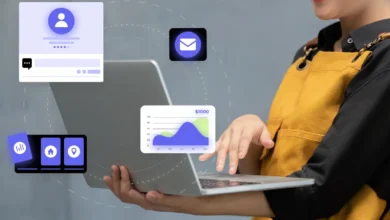Understanding and Using BTL Marketing Strategies

Below The Line (BTL) marketing is a term many in the industry have encountered, yet it remains somewhat enigmatic to those unfamiliar with its nuances. For businesses struggling to connect deeply with their audience, distinguishing between BTL and ATL marketing can be tricky. This blog aims to bridge that gap, offering insights into the definitions, strategies, and implementation of BTL marketing.
You’ll find detailed explanations of how BTL differentiates from ATL, historical context, and a variety of effective BTL strategies such as direct mail and email marketing. Learn to identify your target audience and create compelling content while exploring the advantages and best practices to make the most of your BTL campaigns.
Whether you’re planning a targeted marketing campaign or looking for examples of successful executions, this comprehensive guide is tailored to enhance your marketing efforts with precision and impact.
Understanding BTL Marketing
Below The Line (BTL) Marketing
Below The Line (BTL) marketing focuses on a more direct and personalized way of interacting with specific consumer groups. Unlike its counterpart, Above The Line (ATL) marketing, which is designed to reach a broader audience through traditional media like television and radio, BTL methods include direct mail, email marketing, telemarketing, and special events. This approach allows marketers to target niche audiences more effectively and often at a lower cost.
Differences from ATL Marketing
BTL marketing excels in connecting with niche audiences personally, unlike ATL which focuses on broad brand awareness. A Reddit thread dives deeper into the nuances of ‘The Line’, discussing aspects like media commissions and profit margins that form the boundary between ATL and BTL activities. Read more here.
What is the meaning of ‘The Line’ in ATL and BTL marketing?
by u/kidakaka in marketing
Historical Context and Evolution
Historically, ATL dominated the scene with its reliance on mass media. However, its generic approach meant it couldn’t cater to the personalized need of every consumer. Enter BTL marketing, which gained momentum due to its targeted, direct communication strategies. This evolution marked a shift from generalized marketing to more personalized strategies, paving the way for meaningful consumer engagement.
The rise of digital technologies marked a significant leap for BTL marketing. Email and social media platforms have revolutionized how marketers reach audiences, leveraging data analytics to craft sophisticated campaigns. The digital shift elevates BTL from basic in-store promotions and telemarketing to comprehensive, data-driven strategies targeting a global audience. To understand these strategies better, check out this detailed YouTube video that explains the core concepts and strategies of BTL marketing.
BTL Marketing Strategies
Below-the-Line (BTL) marketing strategies offer a range of methods for brands to engage with their target audiences on a more personalized level.
A traditional method, Direct Mail
involves brands sending tailored flyers, brochures, or catalogs directly to potential customers. This approach makes the recipient feel specially valued by the brand, fostering a deeper connection. In today’s digital age, Direct Mail serves as a refreshing change from the constant barrage of online communications.
Email Marketing
takes the concept of personalized mailing into the digital realm, allowing brands to convey tailored content, exclusive offers, and product suggestions directly to a consumer’s inbox. This form of communication is easily measurable through metrics like open and click-through rates, facilitating precise adjustments to campaigns.
Experiential Marketing
is the art of engaging consumers through memorable, hands-on experiences such as in-store promotions, product demonstrations, or immersive events. These interactions aim to create a lasting emotional bond with the brand. To explore more about this dynamic field, check resources like EventMarketer and AdWeek.
Sponsorships
are another significant facet of BTL marketing. By partnering with events or influencers, brands can tap into niche audiences that align with their market, enhancing their reach and credibility simultaneously.
- Digital and Social Media Marketing: enhance BTL capabilities by targeting specific audience segments based on demographics, interests, and behaviors. Social media platforms, when used strategically, enable brands to communicate directly with select groups, marking them under BTL marketing.
Integrating these strategies focuses on relationship building, a key strength of BTL marketing. As marketing continues to evolve with trends like AI-driven campaigns and personalization at scale, BTL methods remain pivotal in meeting consumers where they are in the most personalized way possible.
For more insights into emerging trends and budget allocations, explore this source.
Implementing BTL in Sales
Identifying the Right Target Audience
Identifying the right target audience is the cornerstone of successful BTL marketing. This involves a meticulous segmentation process where audiences are broken down by demographics, psychographics, and behavioral patterns. By conducting thorough market research through various methods such as surveys and focus groups, marketers can gain a deep understanding of customer preferences and behaviors. Tools like customer relationship management systems prove invaluable here, as they help in gathering essential data, enabling brands to engage with their audience in a more personalized manner. It’s also crucial to perform customer journey mapping, which identifies the most effective touchpoints for BTL efforts throughout the buying process, from awareness to conversion.
Content Creation and Messaging
Use gathered data for personalized content that speaks directly to customer segments. Messaging should not only resonate but also address specific customer needs and challenges, highlighted through storytelling and clear calls to action. This emotional connection fosters a stronger bond and positions the brand more effectively against competitors. Highlight the product’s unique value in addressing customer needs to make the messages effective.
Optimizing Channel Selection
Optimizing the choice of channels is equally vital. Engaging with customers through direct mail offers tangible, personalized connections, while experiential marketing via events and trade shows creates immediate interaction opportunities. Using data-driven targeting enables marketers to focus their efforts on the most promising prospects, ensuring maximum visibility for their product or service. Integrating a mix of channels, from mobile marketing to social media, can amplify the reach and impact of BTL campaigns. Cross-channel integration ensures that the brand message remains consistent across various platforms, enhancing brand visibility and coherence. Additionally, leveraging analytics to assess campaign performance allows marketers to refine their strategies in real-time, ensuring resource allocation is both effective and efficient.
Collaborations help brands expand reach and credibility. Implementing loyalty and referral programs further boosts customer retention and attraction, turning existing customers into brand advocates who help in driving new leads. This multifaceted approach to BTL marketing helps create a robust sales pipeline and fosters a lasting connection with the audience.
Advantages of BTL Marketing
Direct Customer Engagement
BTL marketing enables two-way consumer communication, unlike ATL’s one-way approach. This interaction humanizes the brand, making it more relatable and strengthening the bond between the brand and its audience. BTL fosters loyalty using in-store, social media, and personalized emails to understand consumer needs.
Cost Efficiency
One of the standout advantages of BTL marketing is its cost efficiency. By focusing marketing efforts on specific consumer segments, businesses can optimize budget spending and achieve a higher return on investment compared to broad ATL campaigns. This targeted approach helps direct expenditures toward audiences most likely to convert, enabling even companies with smaller budgets to effectively compete in their markets. Learn more about cost efficiency in BTL marketing here.
Measurable Impact
BTL marketing is celebrated for its measurability. By utilizing exact metrics such as open rates and conversion rates, businesses can clearly assess the effectiveness of their campaigns. Even feedback through surveys offers valuable qualitative insights. Access to such data empowers brands to refine their marketing strategies, ensuring that future efforts are more aligned with consumer preferences and needs.
Flexibility and Adaptability
The adaptability of BTL marketing is pivotal in its success. The ability to make real-time adjustments to campaigns based on immediate feedback and performance analytics keeps brands current with market trends and consumer preferences. This real-time responsiveness ensures that BTL marketing campaigns remain successful and relevant over time.
Examples of Successful BTL Campaigns
Red Bull
Red Bull has mastered the art of using event sponsorships to create memorable brand experiences. Since beginning with a sponsorship deal in 1989, Red Bull has expanded its reach into extreme sports and events like the Red Bull Air Race and Red Bull Stratos project. The latter, featuring skydiver Felix Baumgartner’s record-breaking jump from the edge of space, drew massive global attention, highlighting how effectively event sponsorships can engage audiences. These events have redefined Red Bull as a lifestyle brand synonymous with adventure.
Coca-Cola’s ‘Share a Coke’ Campaign
Coca-Cola’s ‘Share a Coke’ campaign leveraged personalization to deeply engage customers by replacing the iconic logo with names, creating a personal connection. Rolled out in over 80 countries, it significantly boosted sales and market share, demonstrating the power of a personalized touch in building brand loyalty. The campaign generated a viral buzz on social media, where people shared photos of their personalized bottles, amplifying its reach and creating a shared community experience.
IKEA’s In-Store Experiences
IKEA’s in-store experiences blend innovative technology and psychologically driven store design to create personal and emotional connections with customers. By using augmented reality in ‘The Giving Bag AR’ experience, IKEA directly engaged consumers, making shopping more interactive. Their strategic store layout encourages exploration and prolonged visits, often resulting in higher purchase rates. Elements like labyrinthine pathways, mock rooms, and abundant displays of affordable items, combined with a relaxing in-store restaurant, enhance customer experience and drive sales.
Spotify’s ‘Wrapped’ Campaign
Spotify’s ‘Wrapped’ campaign utilizes personalization and data-driven insights to engage users meaningfully. By synthesizing a year’s listening habits into unique user reports, Spotify enhances user engagement and encourages sharing on social media, effectively promoting the platform and fostering a sense of community among participants. The campaign’s viral nature demonstrates the effectiveness of leveraging personal data to create a powerful, shared social experience.
These examples underscore how BTL marketing strategies can foster deep, personal connections between brands and consumers, resulting in increased loyalty and engagement.
Best Practices for BTL Marketing
Conducting Audience Research
When it comes to BTL marketing, engaging with the right audience is paramount. Conducting thorough audience research is the first step. By segmenting your market based on key demographics such as age, gender, and location, you can identify specific groups that are more likely to connect with your product or service. Creating detailed buyer personas, considering their interests, purchasing behavior, and pain points, ensures that your marketing efforts are effective.
To get deeper insights into your audience’s preferences and motivations, tools like social media listening and web analytics are invaluable. They help refine a marketing plan that aligns well with your audience’s needs.
Securing Relevant Permissions
Securing relevant permissions is fundamental in BTL marketing, particularly when personalized communications are involved. Marketers must comply with regulations such as the CAN-SPAM Act and the TCPA. Being transparent in data collection and communicating how the data will be used helps build a trustful relationship with your audience, which is vital for successful engagement.
Integration with Overall Marketing Strategy
To enhance the effectiveness of BTL marketing, integrating it with ATL (Above the Line) and TTL (Through the Line) strategies is crucial. This integration ensures a consistent brand message across all channels. Real-time analytics are pivotal for tracking BTL strategy performance, enabling marketers to make timely adjustments.
Furthermore, creating feedback loops between BTL and other marketing avenues ensures that insights from one channel enrich and improve others, fostering a truly integrated marketing effort.
When to Use BTL Marketing
To effectively deploy BTL marketing, it’s crucial to understand when it is most beneficial. BTL marketing is especially advantageous for businesses that need to connect with highly specific audience segments.
Targeting Specific Audiences
The power of BTL marketing lies in its precision. Businesses looking to reach a particular demographic or geographic audience can use this strategy to tailor their messages and offerings. With tools like data analytics, companies can hone in on key audience characteristics, ensuring that the marketing efforts are as focused as possible.
- This is especially useful for businesses with niche products or services, as it allows them to engage directly with the most interested consumers, reducing wasted efforts and resources.
Gathering Customer Feedback
BTL marketing allows efficient customer feedback gathering. By using methods such as face-to-face interactions, emails, and surveys, businesses can collect invaluable insights into customer preferences.
- This feedback is often gathered in real-time, enabling companies to quickly adjust their strategies and improve customer satisfaction.
- Engaging with customers through their preferred communication channels enhances both the relevance and effectiveness of the feedback collected.
Promoting Local or Niche Products
BTL marketing’s strength also lies in promoting local or niche products. It provides a cost-effective solution for small businesses or those focusing on specific market segments.
- By investing in these tailored marketing strategies, businesses can avoid the broad, often wasteful campaigns. Local companies can benefit by engaging closely with their communities through sponsorships or by hosting events, thereby building relationships and strengthening brand loyalty.
- For niche businesses, BTL marketing allows for crafting personalized experiences that meet the unique needs of their audience, leading to higher customer retention rates.
Integrating BTL and ATL for Maximum Impact
BTL marketing stands out for its ability to engage consumers directly. This is achieved by tailoring experiences that resonate on an individual level, such as through personalized offers and targeted communication. The essence of BTL lies in its power to make brand interactions feel personal and meaningful.
Incorporating BTL with ATL strategies enhances a brand’s ability to reach its audience effectively. This complementary nature boosts the overall marketing strategy by combining the expansive reach of ATL with the direct engagement qualities of BTL. Known as Through the Line (TTL) marketing, this approach creates a comprehensive strategy that benefits both brand recall and conversion rates.
Example of Integration
An illustrative example of this integration would be the use of a television advertisement to build broad brand awareness, paired with a digital campaign offering exclusive deals to those who viewed the ad. Such synchronization across platforms ensures a seamless consumer journey and maximizes the effectiveness of marketing efforts.
Importance of Data Analytics
The role of data analytics is crucial in refining these strategies. By analyzing engagement metrics, brands can adapt their campaigns to remain relevant and impactful. This ability to deliver personalized experiences further cements the importance of integrating ATL and BTL strategies in maintaining loyalty and engagement. For more insights, check out the Research Study on TTL Marketing.





